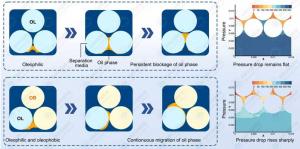Granular beds with asymmetric wettability enhances migration and separation of petroleum hydrocarbon pollutants
GA, UNITED STATES, October 22, 2025 /EINPresswire.com/ -- In a new study titled “Granular beds with asymmetric wettability promote the migration and separation behavior of petroleum hydrocarbon pollutants: Migration rate and pressure drop distribution,” published in Water & Ecology, a research team led by Wenjie Lv from East China University of Science and Technology develop a novel granular beds with asymmetric wettability microchannel structure combining oleophilic and oleophobic surfaces to enhances oil migration and separation the oil phase in oil-in-water emulsions. This study provides an efficient, low-energy pretreatment strategy in treating refinaery wastewater containing highly viscous, easily emulsified petroleum hydrocarbons that are difficult to separate.
A research team led by Wenjie Lv from East China University of Science and Technology proposed an asymmetric wettability microchannel structure to treat refinaery wastewater containing highly viscous and easily emulsified petroleum hydrocarbons that are difficult to separate.
By combining oleophilic and oleophobic surfaces, the granular beds with an asymmetric wettability microchannel directs oil droplets to migrate more efficiently, reducing blockages and energy consumptions. The findings were recently published in Water & Ecology.
“Through numerical simulations and high-speed camera tests, we systematically examined oil droplet adhesion, migration and separation in microchannels, as well as quantitatively correlated oil droplet migration rates with pressure drop distribution in combined wettability systems,” shares Lv.
Furthermore, by applying the extended Derjaguin–Landau–Verwey–Overbeek (XDLVO) theory, the research team elucidated the microscopic adhesion and migration mechanisms from an interfacial energy perspective.
The difference in wettability difference plays a crucial role in determining interfacial fluid behavior. On the OB (oleophobic media) surface, a stable water film forms due to the strong water-solid attraction.
“When the oil phase encounters the OB surface, the water film minimizes oil adhesion, often causing the oil droplets to slip or rebound–guiding them towards the OL (oleophilic-media),” explains LV. “Conversely, on the OL surface, the oil phase replaces the weak water–solid interaction to form a stable oil film.”
In OL-OB microchannels, the oil-solid contact forms a liquid bridge that blocks the pores, leading to an increase in bed pressure drop. In OL-OB media microchannels, the oil film selectively adheres to the OL surface, avoiding pore blockage, ensuring smooth flow of the continuous water phase, and reducing the pressure drop.
“The wettability gradient between the OL and OB surfaces also induces a wetting force that drives the oil phase to migrate from the OB surface to the OL surface, promoting effective coalescence,” adds Lv. “Therefore, the combined use of OL and OB can achieve synergistic effects: the high oil affinity of OL enhances wetting and coalescence efficiency, while the high water affinity of OB promotes water film formation, which not only improves water flux but also reduces bed pressure drop.”
Notably, the study identified the optimal operating conditions for operating the asymmetric microchannels. Compared to 30° and 120° or 30° and 150°, the microchannel combinations with oil phase contact angles of 30° and 90° significantly improved oil phase migration rate by 31.4% to 66.7%, while reducing flow field pressure drop by 25% with optimal velocity at 0.015 m/s.
Using the extended Derjaguin-Landau-Verwey-Overbeek theory, the team further revealed OL parts promote coalescence while OB parts form water films, enabling efficient separation. The findingsoffer a reliable technical pathway for optimizing energy consumption and scaling up the engineering application of oily wastewater pretreatment processes.
DOI
10.1016/j.wateco.2025.100019
Original Source URL
https://doi.org/10.1016/j.wateco.2025.100019
Funding information
This research was supported by the sponsorship of the National Natural Science Foundation of China (Grant No. 52322003) and Shanghai Excellent Academic/Technical Leaders Program (23XD1431900).
Lucy Wang
BioDesign Research
email us here
Legal Disclaimer:
EIN Presswire provides this news content "as is" without warranty of any kind. We do not accept any responsibility or liability for the accuracy, content, images, videos, licenses, completeness, legality, or reliability of the information contained in this article. If you have any complaints or copyright issues related to this article, kindly contact the author above.

